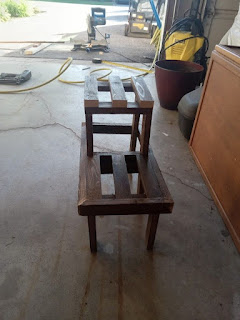May 5th, 2024
Staining wood can be done with a professional finish! Here's a breakdown of the steps involved, with a focus on using a brush: Understanding the procedures will ensure that your project turns out beautifully. Staining wood differs greatly from painting.
We will go over all you need to know and how you will be impressed by your results.
Preparation is Key:
Sanding:
This produces a surface that is smooth enough to absorb stains evenly. For wood that has already been finished, use 120-grit sandpaper; for bare wood, use 80-grit; and for all surfaces, use 180-grit. Use a tack cloth to remove dust.
 |
| Give your wood a smooth sanding |
Pre-conditioning (optional):
Use of a pre-stain conditioner should be considered for softwoods such as pine. This lessens the likelihood of applying blotchy stain. Apply using a foam brush, allow to dry as directed by the product, and then remove any leftovers with a clean cloth.
How to apply the stain:
Brush Choice:
Synthetic brushes are appropriate for water-based stains, but natural bristle brushes perform better on oil-based stains. Select a premium brush with non-stretching, soft bristles. This is a crucial choice that will affect the kind of stain you use.
One of the best brushes for applying stain is a natural bristle brush because it can be cleaned and used again for several projects. The best brushes to use with 100% acrylic and oil or acrylic stains are synthetic ones. It's not like natural bristles that will go limp.
 |
| My choice for staining |
Stain Application:
Before using the stain, always give it a good stir. Stain should be applied in light, even coats, following the grain. Use a fresh, lint-free cloth to quickly wipe away any excess stain in the direction of the grain. Using these techniques will enhance the finished look of your work.
Building Colour:
For a deeper colour, apply additional thin coats only after the first coat has completely dried (see the stain can's drying time). Recall that adding more stains is simpler than removing them.
Expert Advice on Brushwork:
Let's go over the procedures you must adhere to in order to finish any project you undertake flawlessly. Whether you're staining a wooden swing set, a deck, or any other wood project you've got planned,.
Work in sections: To prevent uneven drying, apply stain to small, manageable sections at a time.
 |
| This is the correct way to stain |
 |
| Incorrect way, you can see the uneven application of the stain |
Maintain a wet edge: To guarantee even application, dip your brush frequently and leave a wet edge on the stain as you work.
Wipe thoroughly: It's imperative to remove excess stains as soon as possible to achieve a polished appearance. Keep the stain from collecting on the surface. One of the most common mistakes people make when staining is this:.
Clean your brush: After staining, store your brush carefully after giving it a thorough cleaning with the suitable solvent (water for a water-based stain, mineral spirits for an oil-based stain). To keep your brush wet until I need it again, I wrap it in saran wrap while I'm taking a break.
Additional Tips:
Test not only the stain colour but also the wiping times! Stain a scrap piece, allow it to sit for varying amounts of time (30 seconds, 1 minute, 2 minutes, etc.), and then remove it with a cloth. This will demonstrate how the stain penetrates the wood and how the length of time you leave it on before wiping affects the final colour.
Drop Cloth Magic:
Use a plastic drop cloth that drapes over the floor and has slightly folded edges for the best results. This will capture any spills or drips and simplify cleanup. Another useful trick with painter's tape is to draw straight lines around the edges of your workspace to keep stains from seeping onto surfaces you don't want coloured.
Ventilation Ventilation Ventilation:
This only applies if you are working indoors; otherwise, take safety measures. Stains can release strong fumes, particularly those that are oil-based. To promote proper air circulation, open the doors and windows. Try to work outside on a day with little wind. When handling stains, always wear a respirator made for organic vapours, and make sure you follow the manufacturer's instructions for safe usage.
Conclusion
You will obtain results that a professional would provide if you follow the above steps. This deck serves as an illustration of a stain job done differently. The difference will be apparent to you right away. While one section was completed erroneously, the other section adhered to the right procedures.
 |
| You will notice the difference with the staining process |
Feel free to leave your feedback or any question you may have.
Regards,
We appreciate you visiting our site and your comments on our subjects. Subscribe to our blog to get a copy of "Repair Smart: Money-Saving Maintenance Hacks for Homeowners." This ebook offers practical advice on how to control expenses for your do-it-yourself house renovations. Simply leave a comment to request a free copy of our ebook.
 |
Request a complimentary copy of this ebook. |




















